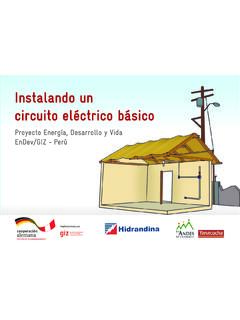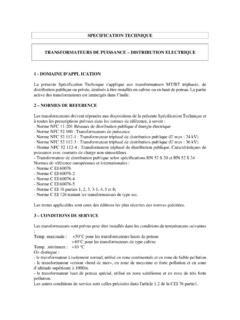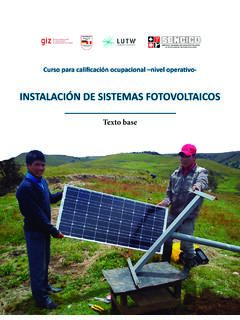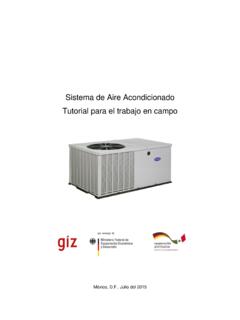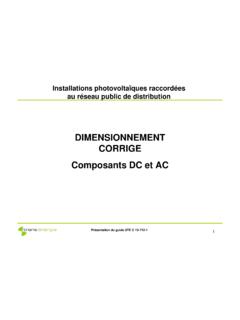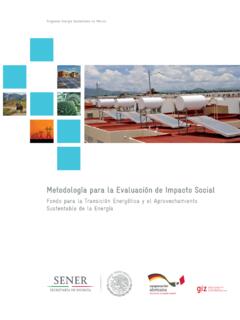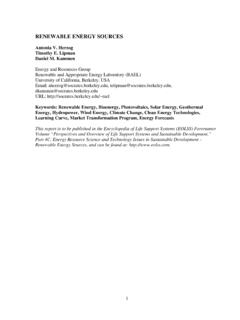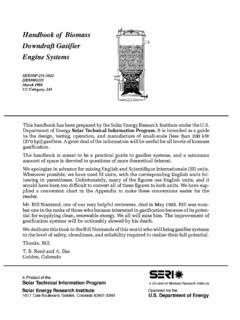Transcription of Small-scale Electricity Generation from Biomass Part I ...
1 Small-scale Electricity Generation from Biomass Experience with Small-scale Technologies for Basic energy Supply part I: Biomass Gasification Small-scale Electricity Generation from Biomass part I: Biomass Gasification 2nd edition, November 2011, Eschborn Author: Elmar Dimpl Editors: Michael Blunck, Heike Volkmer Cover Pictures: o Wood gasifiyer at Muni Sewa Ashram, India (Dr. Dunja Hoffmann) o Portable 10 kW gasification plant from the US based company ALL Power Labs (Elmar Dimpl) o 300 kW gasification plant in a recycling park Usingen, Germany (Elmar Dimpl) Published by GIZ HERA Poverty-oriented Basic energy Service Small-scale Electricity Generation from Biomass part I: Biomass Gasification Contents Preface.
2 3 1 Introduction .. 4 2 The Technology .. 5 3 Existing Experience in Different Countries .. 7 India .. 8 Sri 9 Cambodia ..10 African countries ..10 Germany ..11 4 Overall Appraisal of the Potentials and Challenges ..13 5 Conclusion and Recommendations ..15 On a policy level ..15 On a research level ..15 On a project s implementation level ..15 Documents and Literature ..17 Preface energy is essential for human development. Without an adequate basic energy supply, peo-ple cannot cook their food, light their homes, or keep essential medication chilled. Alongside the introduction of efficient and clean thermal use of traditional Biomass for cooking, the pro-vision of Electricity from renewable energy sources can provide basic energy services for lighting and communication and promote local economic growth.
3 Renewable energy from photovoltaic s and small hydro plants is highly suitable for off-grid Electricity supply and has been successfully introduced in countless cases in developing countries. However, although the application of Biomass as a sustainable Electricity source seems promising, it is still seldom perceived as an option for providing Electricity for the rural poor. In order to generate Electricity , Biomass can be combusted, gasified, biologically digested or fermented, or converted to liquid fuels propelling a generator. Several research institutions (Mahapatra, Chanakya, Dasappa, 2009) and international agencies, such as the ESMAP programme administered by the World Bank (ESMAP, 2007), rate Biomass as one of the cheapest available renewable energy sources for power Generation .
4 Furthermore, conversion from Biomass to Electricity can be a low-carbon process as the resulting CO2 is captured by plant re-growth. In contrast with solar PV or wind power, Biomass power technology can generate Electricity on demand at any time, as long as a sufficient supply of Biomass stocks is assured. Many agricultural and forest product residues can provide feedstock for energy conversion without increasing land requirements. In addition, local farmers can generate ad-ditional income by providing Biomass fuels for small local power plants. However, despite the apparent benefits, there has been little experience of implementing small Electricity -generating Biomass plants in off-grid areas of developing countries.
5 In ap-proaching this issue, the GIZ programme Poverty-oriented Basic energy Services (HERA) assessed the lessons learned from GIZ and non-GIZ pilot activities and thus identified the most important potentials of and obstacles to different Biomass power technologies. This assessment resulted in a three- part series of papers on Small-scale Electricity Genera-tion from Biomass covering Biomass gasification ( part I), biogas ( part II), and plant oil ( part III) for electric power Generation . 1 Introduction It appears to be a fascinating solution: Wood or other dry Biomass is converted into a com-bustible gas and then into Electricity via a generator set a perfect solution for remote rural areas with a lack of Electricity but an abundance of shrubs, straw, rice and peanut husks or other forms of Biomass .
6 This technology, known as Biomass gasification, has been well known for more than a hun-dred years. In light of rising prices of fossil fuels in 2008 and the debate about climate change, this technology has again come under consideration as a renewable energy source in rural areas. However, converting Biomass to Electricity is not as easy as some manufac-turers would like to make us believe. The Deutsche Gesellschaft f r Internationale Zusammenarbeit (GIZ) on behalf of the Ger-man Ministry for Economic Cooperation and Development (BMZ) has been searching for sustainable solutions to provide access to basic energy services in rural areas and has ana-lysed experiences with Small-scale applications of the gasification technology over the last decades.
7 This analysis was based on publicly available documents, as well as interviews and email discussions with experts in this field. This text summarises the results, revealing sev-eral difficulties and challenges. It refers to Small-scale applications of less than 100 kW and focuses on potentials for providing basic energy services to rural households and small busi-nesses. 2 The Technology Biomass gasification is the conversion of solid fuels, such as wood and agricultural residues, into a combustible gas mixture. An electric generator set with a combustion motor uses this gas as a fuel to produce Electricity . The gasifier is a chemical reactor that uses wood chips, rice husks, coal or similar carbonaceous materials as fuel and burns them in a process of incomplete combustion due to a limited air supply.
8 Products of the gasification process are solid ashes, partially oxidized products like soot (which have to be removed periodically from the gasifier), and generator gas. The main flammable components of the resulting generator gas are Carbon monoxide (CO), Hydrogen (H2), and Methane (CH4). Due to its high content of nitrogen (more than 50%) and other incombustible components, this producer gas has a low calorific value compared to other fuels. The calorific value of generator gas is only about 5 -6 MJ/kg versus 35-50 MJ/kg for natural gas. There are many different gasification methods in use or in development, but the Small-scale power gasifiers use almost exclusively the downdraft fixed-bed technology.
9 The air/gas stream moves downwards through a fixed (not fluidized) bed of woodchips. This is the only economic option on a Small-scale that also produces a fairly clean gas. Theoretically, Electricity can be produced by various kinds of technical equipment, such as a combustion unit in combination with a steam turbine, a gas turbine, a Stirling motor, or even a fuel cell. In practice, internal combustion piston engines are almost exclusively used to drive electric generators for the Small-scale applications discussed here. Apart from some minor adaptations, this generator set is more or less the same as used with other fuels.
10 Spark ignition Otto engines as well as compression ignition diesel engines can be used. While the Otto engines can be operated on generator gas only, diesel engines generally need co-fuelling of conventional diesel fuel. All internal combustion engines require a very clean gas as a fuel. Otherwise, excessive en-gine wear and low power output will inevitably occur. Therefore, a cleaning system is an es-sential component of a gasifier plant. Cleaning systems that use water to wash out the undesired components are quite efficient. However, they produce a high quantity of toxic and carcinogenic liquid waste.



